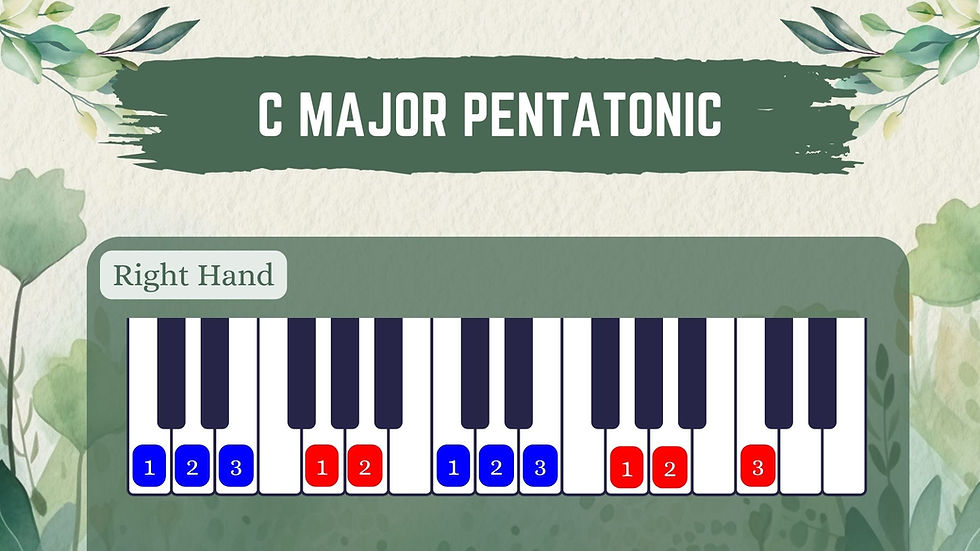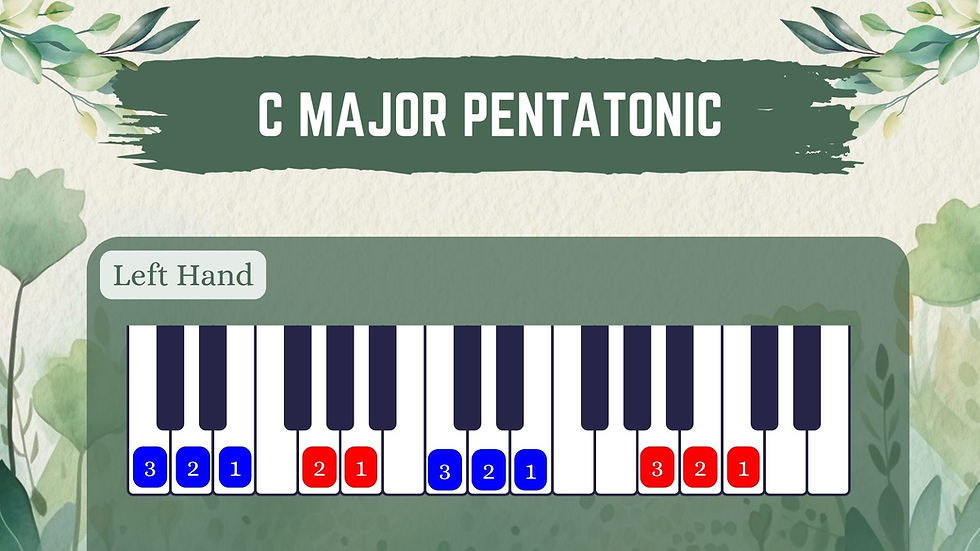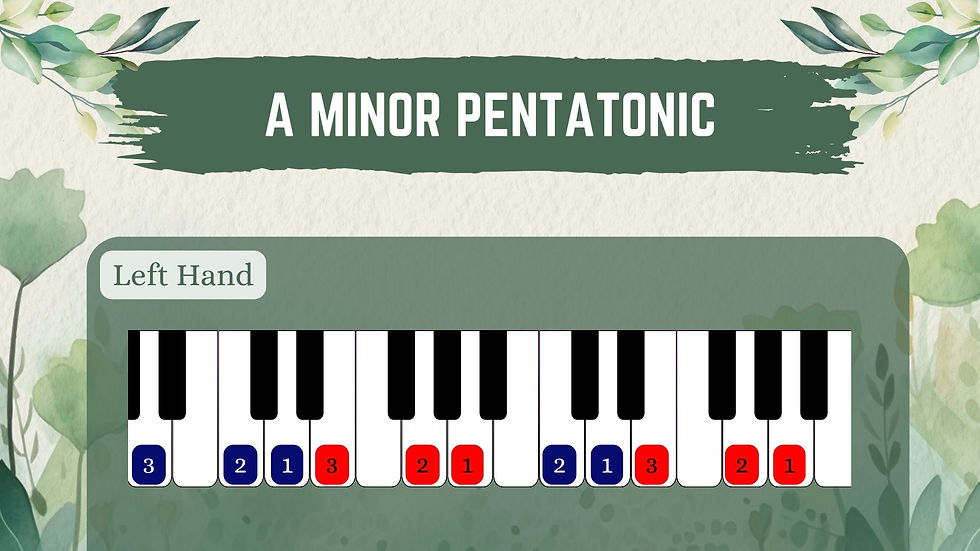Unlock Your Musical Creativity with the Pentatonic Scale
- Sep 20, 2025
- 6 min read
Have you ever sat at a piano or picked up an instrument, dreaming of creating your own melodies on the spot, only to feel paralysed by the sheer complexity of music?
The endless scales, chords, and rules can feel like an insurmountable wall, keeping your creative ideas locked away. It's a common frustration that stops many aspiring musicians before they even begin.
The secret to unlocking your musical creativity isn't about learning more, but about using less? What if a simple, ancient, five-note scale held the key to confident and beautiful improvisation, even for a complete beginner? This isn't a shortcut around learning; it's a direct path to the heart of musical expression.
This article will reveal four surprising takeaways from exploring the pentatonic scale, a powerful tool that strips music down to its most essential, harmonious elements. You'll discover how fewer notes can lead to more freedom, how to create an instant atmosphere with a timeless technique, and how to use your own feelings as the ultimate guide to creating music that is uniquely yours.
At its core, the pentatonic scale is simply a scale with five notes.
For example, the A minor pentatonic scale uses the notes A, C, D, E, and G. The C major pentatonic uses C, D, E, G, and A. The true magic of this scale, however, isn't in the notes it includes, but in the ones it removes. It's built by taking a standard seven-note scale and strategically omitting the two notes most likely to clash.
For the C major pentatonic, you leave out the 4th and 7th notes (F and B).


For the A minor pentatonic, you leave out the 2nd and 6th notes (B and F).


This simple act of removal is what makes the pentatonic scale such a powerful tool for improvisation. It creates a foolproof musical sandbox where it's virtually impossible to play a "wrong" note.
The reason this scale is so popular for beginners and improvisation is that all five notes sound good together. The scale leaves out the two notes (B and F) that would create the harshest-sounding musical intervals, or clashing notes. You can play the notes in any order, and it will always sound musical and correct.
For anyone who has ever felt the fear of hitting a wrong note, this concept is incredibly liberating. It removes the technical anxiety and allows you to focus purely on rhythm, melody, and creative expression, knowing that any combination of the five notes will sound inherently musical.
Create an Instant Atmosphere with an Ancient Drone
Once you're comfortable with the five notes of the scale, you can create a rich, atmospheric soundscape with a surprisingly simple technique: the drone. By playing just two notes with your other hand—the first and fifth notes of the scale—you establish a stable harmonic foundation.
For the A minor pentatonic scale, this means holding down an A and an E with your other hand. For C major, it's a C and a G. This simple two-note chord instantly creates a rich sonic bed for your melody.
This isn't a modern trick; it's a timeless musical device. Drones are commonly found in "modes, pentatonic scales, folk songs, and various cultural scales," giving your improvisation an instantly evocative and ancient quality.
The power of this technique lies in its simplicity. By creating a consistent and pleasing harmonic base, the drone frees you from thinking about complex chord changes. Your entire focus can shift to the melodic journey of your improvising hand, allowing for deeper exploration of rhythm and melodic shape without distraction.
Use Your Feelings as a Creative Compass
Shift your focus from technique to emotion. A unique and powerful practice encouraged throughout the exploration of the pentatonic scale is the use of "Creative Reflection," or musical journaling. This practice intentionally shifts the focus away from purely technical questions ("Did I play the right notes?") and toward emotional and sensory exploration ("How did the music make me feel?").
Instead of just practicing scales, you're prompted to pause and reflect on the atmosphere you've created. The journaling prompts are specific and evocative, designed to connect your musical ideas to deeper sensory and narrative experiences:
What colour, weather condition, or emotion does the music evoke?
What aroma, taste, or memory does it bring to mind?
If you were to give this music a title, what would it be?
Imagine a short film for this music. What scenes are playing out?
This practice is transformative. It encourages you to think like a composer, connecting the sounds you create to moods, images, and stories. By regularly asking these questions, you begin to understand your own musical instincts and develop a personal artistic voice that goes far beyond technical proficiency.
Tell a Story With Just a Few Chords
Building narrative with simple harmony. After exploring melody over a drone, the next step is to introduce simple chords to create a sense of movement and narrative. This doesn't require advanced harmonic knowledge. For the A minor pentatonic, you can build a story by moving between the chords of A minor, D minor, and E minor. For the C major pentatonic, you can alternate between the foundational chords of C major, F major, and G major.
This is where you begin to tell a musical story with a clear beginning, middle, and end. The addition of chords creates emotional arcs of tension and release. For example, when improvising over a C major chord progression, adding the G major chord creates a distinct "feeling of tension" that instinctively "wants to resolve back to C major."
This simple interaction between a melody and a few basic chords demonstrates a fundamental principle of musical storytelling. It shows that you don't need complex progressions to create a compelling musical journey. The emotional weight, the feeling of departure, and the comfort of returning home can all be built from these simple, powerful, and accessible blocks.
Conclusion: Your Music is Waiting
The journey into musical improvisation doesn't have to be intimidating. The pentatonic scale proves that creativity is not born from overwhelming complexity, but from the mastery of simple and powerful tools.
By limiting your notes, you expand your freedom.
By adding a simple drone, you create a world of sound.
By reflecting on your feelings, you find your voice.
And with just a few chords, you learn to tell a story.
The path to creating your own music is more accessible than you think. The building blocks are right here, waiting for you to arrange them into something new. So, ask yourself the question that lies at the heart of all this exploration:
If you only had five notes, what story would you tell?
Download the Workbook
Answer the following questions in 2-3 sentences each, based on the above article.
What are the five notes that constitute the A minor pentatonic scale?
How is a major pentatonic scale constructed from a standard major scale, according to the source material?
Describe the technique for creating a "drone" in the provided exercises and list the musical styles where it is commonly used.
In the "A minor Pentatonic Improvisation 4" exercise, which three chords are used in the chord progression?
What is the stated reason that the A minor pentatonic scale is particularly effective for beginners and improvisation?
Identify the five notes of the C major pentatonic scale and the standard right-hand fingering mentioned for it.
What is the purpose of the "Creative Reflection" or music journal prompts that appear at the end of each improvisation exercise?
In the C major improvisation exercises, which chord is identified as the subdominant, and which is the dominant?
According to "C Major Pentatonic Improv. 4," what feeling does the G major chord create, and which chord does it typically resolve to?
Besides holding chords, what are some of the other techniques suggested for adding variation to the improvisation exercises?



